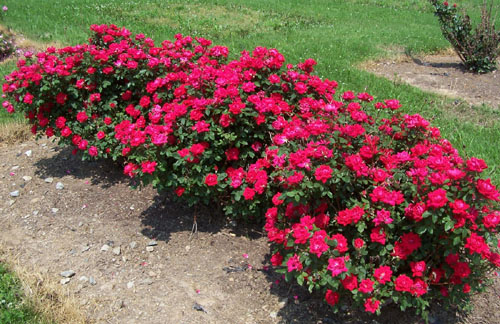Roses are not as fragile as they might appear and you could probably plant them in a hole here in the Dallas area and have some success. But a little extra effort when planting your roses will pay off with a much healthier plant and more prolific blooms. Here are some tips and tricks of the trade for how to plant roses.
Where to Plant Roses
Roses are not terribly picky about soil, but since they are a heavy feeding plant, a rich loam type would be ideal. The soil pH can be slightly acidic to neutral (5.5 to 7.0). It is usually advisable to work in several inches of organic soil conditioners, especially if you have poor soil or heavy clay. (Uhh- Hello Dallas area ring another bell??)
Make sure the soil has good drainage. Roses need regular deep watering, but their roots will rot if left to sit for days in wet soil. (Raised beds are even better)
And finally, do not crowd your rose bushes. The more air flow around the plants, the less likely they will be to get fungal diseases, like black spot and powdery mildew, on their leaves. (Pay attention here, all you low maintenance folks)
How to Plant Rose Bushes
Dig out a hole that is slightly wider, but about as deep as the roses root ball. This will generally be about 15–18 inches deep x 18–24 inches wide.
Mix a handful of bone meal or superphosphate into the soil you removed from the hole and save it for refilling the hole, once the rose is planted.. This will help the rose bush acclimate to its new home. Don’t feed with anything else at planting time. You want the roots to take hold, before the top start sending out a lot of new growth.
If your rose came in a container, gently remove it from the pot and loosen the roots a bit.
If your rose is bare root, soak the roots for about an hour, before planting.
Make a mound in the center of the hole, with the soil and superphosphate mix. Make the mound high enough so that when you place the rose bush on top of it, the knobby graft union is barely below soil level. When the plant settles, the graft union should be fully buried, about 1 inch underground.
Gardeners in our warm Dallas area climates may prefer to leave the bud union above ground, since there is little chance of frost damage. You can bury the graft no matter where you are gardening, but there is a chance that sprouts will grow from the root stock, resulting in a plant different from the one grafted on top.
Spread the roots down the sides of the mound. Begin filling in with the soil and superphosphate, keeping the roots as spread as possible. Water the soil when the hole is just about filled, to help settle it in. Continue filling the hole and gently pat down.
Water deeply and apply 1–2 inches of mulch. (Shredded cedar is the best) Water at least once per week. (an inch or so)
Additional Tips:
If there is still a chance of deep freezing temps, you can loosely pile soil or mulch around the base of the rose canes, to keep them from drying out. Remove this soil when the temperatures warm.
Prune back the canes of larger rose bushes that are being transplanted to 6–8 inches long
Caring for Roses after Planting
Continue to water every week, so that the plants develop a deep roots system.
Feed roses when they start to leaf out in spring and after each flush of bloom or about every six weeks throughout the growing season.
Stop feeding about 6 weeks before your first frost date, but continue watering.
Question: Jimmie, I have several shrubs and perennials that seem to have been hit pretty hard by our unforgiving winter. Some are showing a tiny bit of new growth, shouldn’t they be leafed out by now. Should I just go ahead and replace them, I really don’t want to wait an entire growing season or two for them to recover. Thank you for your thoughts, I really enjoy your columns! Jill L. in Prosper
Answer: Hi Jill, It was indeed an unusually hard winter on many trees, shrubs and landscaping in general. We are helping many clients all over the Dallas Metroplex with similar issues but if you think about it we just had another late freeze on the night of April 14th so many plants are still waiting for the ground temperature to warm up before fully leafing out and recovering. Try cutting back any obvious dead foliage and do a heavy feeding, I think you might be surprised in another 30-45 days how tough your plants actually are. Give them a fighting chance and they will be stronger for it next winter, you can always replace some at that point if need be. Until next time….Happy Gardening!!

